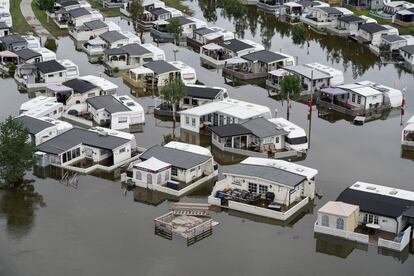More evacuations considered in Norway where the level in swollen rivers continues to rise
The level of water in swollen rivers and lakes continued to grow Friday despite two days of dry but overcast weather, flooding abandoned houses, coating cars in mud and swamping camping sites

Authorities were on standby to evacuate more people in southeastern Norway Friday, where huge amounts of water, littered with broken trees, debris and trash, were thundering down the usually serene rivers after days of torrential rain.
The level of water in swollen rivers and lakes continued to grow despite two days of dry but overcast weather, with houses abandoned in flooded areas, floating hay bales wrapped in white plastic, cars coated in mud and camping sites swamped.
In the Bagdammen lake, a helicopter with a net and cables attached was used to push a caravan toward the shore where it was pulled in by firefighters.
One of the most affected places was the town of Hoenefossen where the Begna river had gone over its banks and authorities were considering moving more people downstream for fear of landslides. A total of 3,600 people are estimated to have been already evacuated, the Norwegian news agency NTB said.
“We constantly try to think a few steps ahead. We are ready to press an even bigger red button,” Magnus Nilholm, a local emergency manager in the Hoenefossen region, told Norwegian broadcaster NRK.
“This has been like a disaster movie,” Solveig Vestenfor, the mayor of Aal municipality that has been affected by the floods, told NRK.
Ivar Berthling of Norway’s Water Resources and Energy Directorate (NVE) told NTB that the water levels around Hoenefossen, some 40 kilometers (25 miles) north of Oslo, were expected to continue rising and remain high until at least Monday. Up north, near the Strondafjorden lake, the water level was reported to be 2.5 meters (8.2 feet) above normal.
“We are still facing critical days,” the Ringerike municipality, where Hoenefossen lies, said in a statement.
“Being evacuated is a dramatic event in everyday life, especially for children,” Prime Minister Jonas Gahr Støre said as he visited one of the affected areas Friday.
Norway’s 86-year-old King Harald V was given a briefing at the NVE headquarters, west of Oslo, on Friday, while his wife, Queen Sonja, was seen scribing on a notepad. The aging king who uses crutches, later met with volunteers who have worked with those evacuated.
“This was really extreme,” Harald told reporters.
His wife added, “I think we have to wait a few days and see, before we can breathe a sigh of relief.”
Authorities did not provide a nationwide count of evacuees. According to a rough estimate, damage so far could amount to 1 billion kroner (nearly $100 million).
Authorities on Friday urged people not to check on their cabins in the devastated part of the country.
“Hytte,” the Norwegian word for cabin, is part of the Scandinavian country’s outdoors lifestyle, and thousands of Norwegians have access to a cabin — some in the mountains, others by the coast — that they use as a retreat from everyday life.
“We fully understand that many cabin owners are anxious about the cabin’s condition after the ravages of the extreme weather, but we hope people will abstain now from making the trip just to check,” Lars Aune of the National Police said in a statement. “This is to avoid unnecessary strain on exposed roads.”
Storm Hans on Monday and Tuesday battered northern Europe, leading to transportation distruption, flooding and power cuts across the Nordic and Baltic region. At least three people were killed.
Southeastern Norway was particularly badly affected. A hydroelectric river dam collapsed Wednesday as water forced its way through, and earlier this week a train derailed in neighboring Sweden when a railway embankment was washed away by floods.
Sign up for our weekly newsletter to get more English-language news coverage from EL PAÍS USA Edition
Tu suscripción se está usando en otro dispositivo
¿Quieres añadir otro usuario a tu suscripción?
Si continúas leyendo en este dispositivo, no se podrá leer en el otro.
FlechaTu suscripción se está usando en otro dispositivo y solo puedes acceder a EL PAÍS desde un dispositivo a la vez.
Si quieres compartir tu cuenta, cambia tu suscripción a la modalidad Premium, así podrás añadir otro usuario. Cada uno accederá con su propia cuenta de email, lo que os permitirá personalizar vuestra experiencia en EL PAÍS.
¿Tienes una suscripción de empresa? Accede aquí para contratar más cuentas.
En el caso de no saber quién está usando tu cuenta, te recomendamos cambiar tu contraseña aquí.
Si decides continuar compartiendo tu cuenta, este mensaje se mostrará en tu dispositivo y en el de la otra persona que está usando tu cuenta de forma indefinida, afectando a tu experiencia de lectura. Puedes consultar aquí los términos y condiciones de la suscripción digital.
More information
Últimas noticias
Most viewed
- Reinhard Genzel, Nobel laureate in physics: ‘One-minute videos will never give you the truth’
- Oona Chaplin: ‘I told James Cameron that I was living in a treehouse and starting a permaculture project with a friend’
- Pablo Escobar’s hippos: A serious environmental problem, 40 years on
- Why we lost the habit of sleeping in two segments and how that changed our sense of time
- Chevy Chase, the beloved comedian who was a monster off camera: ‘Not everyone hated him, just the people who’ve worked with him’










































